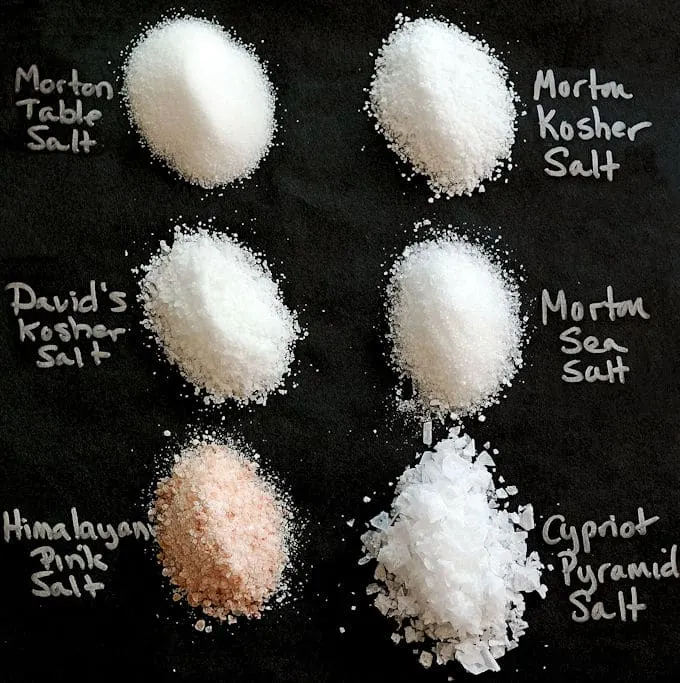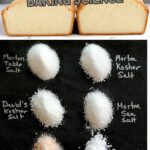🧂 Salt in Baking
Salt is so elemental to food that its name shows up in “salary,” derived from salarium — payment once given to Roman soldiers to buy salt.
It’s in nearly every recipe we make, but salt’s role in baking is far more complex than just “adding a little for flavor.” Salt influences how dough behaves, how batters rise, and how flavors balance.
Table of contents

Types of Salt Used in Baking
Table salt, sea salt, and kosher salt can all be used in baking — but their weights and crystal sizes vary, so equal volumes don’t always measure the same.
Because baked goods rely on precision, even small variations in salt type can noticeably affect the final result. Choose fine-grained salt (like table salt) for doughs and batters, and reserve flaky salts for finishing.
| Salt Type | Weight per Tablespoon | Notes |
|---|---|---|
| Table Salt | 20 g | Fine crystals dissolve easily; ideal for baking. |
| Morton Kosher Salt | 15 g | Dense, smaller flakes than Diamond. |
| Diamond Crystal Kosher Salt | 10 g | Lighter, larger flakes; use more by volume. |
| Granulated Sea Salt | 20 g | Similar in density to table salt. |
| Flaky Sea Salt | 10 g | Best as a finishing salt. |
Baking Sense Tip
A half-teaspoon difference in salt won’t change a pot of soup — but in a cake or bread dough, it can change both flavor and texture.
Salt & Flavor of Baked Goods
Salt enhances flavor without making food “salty.” A small amount reduces bitterness, balances sweetness, and rounds out the overall taste.
In sweet baking, salt brings depth to chocolate, heightens fruit flavor in fillings and curds, and makes caramels irresistible.
In bread baking, it turns bland dough into something full-flavored and aromatic.
Try adding a pinch to:
- Pie fillings and fruit curds — it brightens fruit flavor.
- Jams and jellies — for balance.
- Chocolate desserts — to intensify flavor.
How Salt Reacts with Flour
Salt doesn’t just affect taste; it also influences structure and texture.
Salt molecules bond with flour proteins, tightening gluten strands and creating a more elastic dough.
- In bread dough, this controlled tightening is desirable — it strengthens structure and improves shape.
- In cakes and pastries, too much salt can make the crumb dense and tough.
If you ever notice your bread spreading instead of rising, you may have forgotten the salt — it helps regulate yeast fermentation and strengthens the dough’s network.
How Salt Affects Yeast
Salt plays a crucial role in controlling yeast activity during fermentation. It doesn’t just add flavor, it helps regulate how quickly yeast grows and how evenly dough rises.
When salt is added to dough, it draws some moisture away from the yeast cells, slightly slowing fermentation. This slower rise allows more time for flavor to develop, giving bread a deeper, more complex taste and a finer, more even crumb.
Without salt, yeast works too quickly, the dough can over-proof, collapse in the oven, and develop a yeasty or flat flavor.
Key Effects of Salt on Yeast:
- Regulates fermentation: Prevents yeast from exhausting its food supply too soon.
- Improves texture: Creates a tighter, more uniform crumb.
- Enhances flavor: Slower fermentation brings out subtle, complex notes in the bread.
To avoid inhibiting yeast too much, never mix salt directly with dry yeast. Add them on opposite sides of the mixing bowl or dissolve the salt into the liquid ingredients before combining.
How Salt Affects Eggs
Salt “denatures” or loosens egg proteins. A small pinch in egg wash thins it slightly, making it easier to brush evenly onto pastries or rolls. The same principle helps custards and quiches set more gently and evenly.
📘 Continue Learning
This page is part of my Baking Ingredient Science series, where I explain how each ingredient affects texture, flavor, and structure in baking.
Explore more ingredient guides:
- Flour in Baking – structure and gluten formation
- Sugar in Baking – sweetness, tenderness, and moisture
- Fats in Baking – richness and flakiness
- Eggs in Baking – structure and emulsification
- Chemical Leavening in Baking – rise and aerate
- Yeast in Baking – fermentation and flavor
- Chocolate in Baking – flavor and structure

